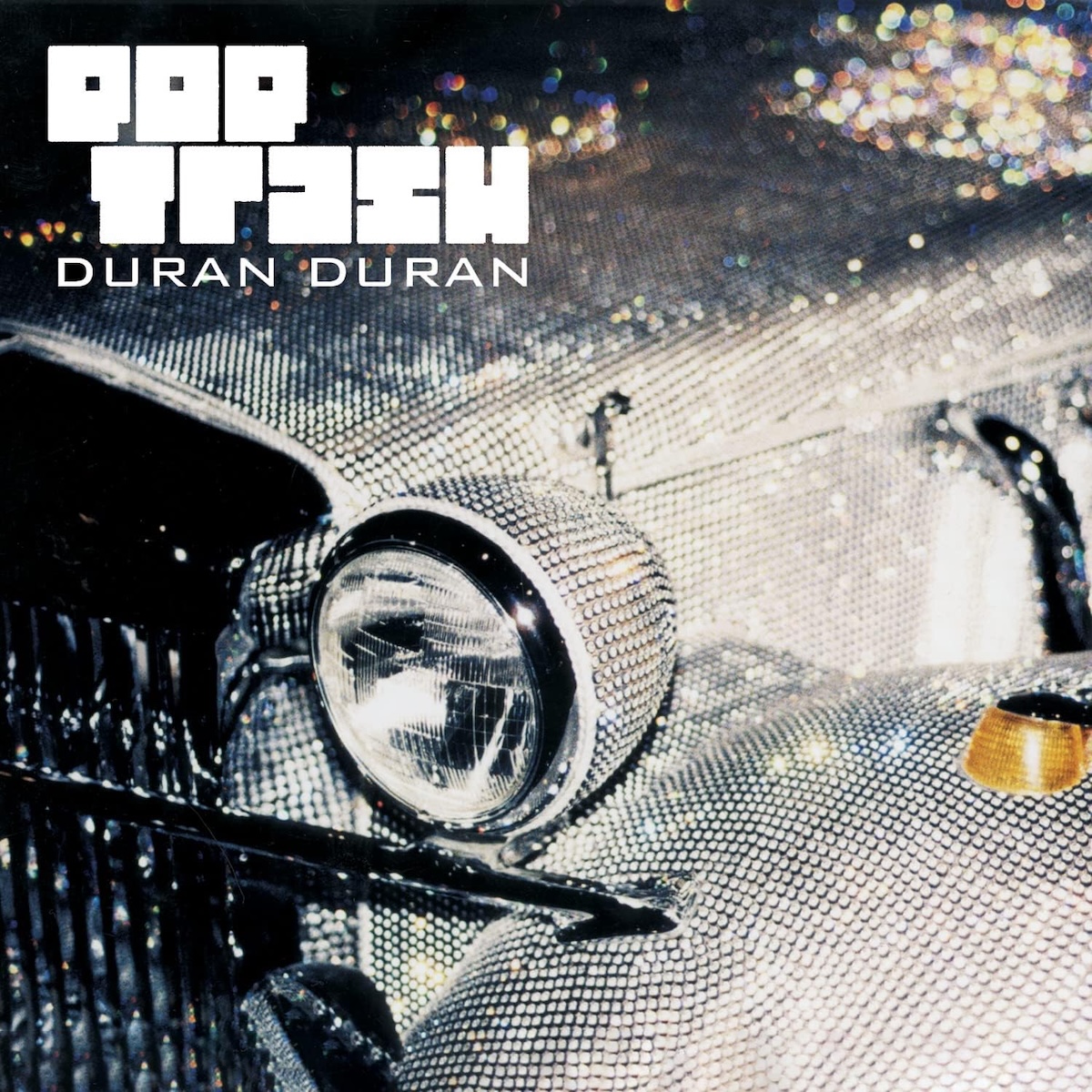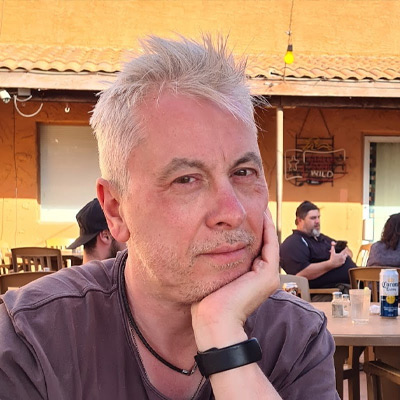The band’s first release after parting ways with EMI saw them land on shaky ground with a rocking sound

Their only album without John Taylor and the last with Warren Cuccurullo, Pop Trash is an outlier in the Duran Duran discography, and one that remains one of their worst performing…
After suffering a critical mauling with Thank You and a commercial kicking with Medazzaland, Duran Duran needed to impress with their 10th album. All told, the late 1990s weren’t a great time for the band – they’d lost John Taylor in 1997, while Medazzaland was, due to dismal sales in the US, not even released in the UK. While John’s playing appears on four tracks off that album, the next record would be the only Duran LP not to feature him at all.
In fact, you could make an argument that Pop Trash is even less a Duran Duran album than Arcadia’s So Red The Rose, as at least that featured three original band members. Of that classic line-up only Simon Le Bon and Nick Rhodes feature on the band’s 10th official album, alongside, of course, latecomer Warren Cuccurullo.
Rocky Sound
Two years before Pop Trash’s release in June 2000, Duran had parted ways with Capitol/EMI, and subsequently inked a deal with Disney Music Group’s Hollywood Records, for what was intended to be three albums. Except Pop Trash would be the only LP they ever delivered to the House of Mouse. It would also close a chapter on the band. But more on that later.
It must be said that Pop Trash is few Duran aficionados’ favourite record. It was, according to engineer Ken Scott, meant to be “an edgier album”, but is that what fans brought up on Rio and Union Of The Snake really wanted? Throughout the 90s, Warren Cuccurullo’s contribution to the songwriting had been increasing, and certainly the American guitarist was bringing with him a harsher, rockier sound than had made Duran’s name in the 80s.
One of the biggest differences, in terms of the songwriting credits on Pop Trash, was that Simon was suffering a chronic case of writer’s block during the making of the album. With Le Bon taking a backseat, Rhodes and Cuccurullo took on more of the writing, reworking some of their TV Mania material for inclusion on the record. The two began working on the album in the guitarist’s studio, often without their singer present. “Simon maintained a punishing social schedule,” the keyboardist is quoted as saying in Stephen Davis’ 2021 book, Please Please Tell Me Now. “I’d be in the studio until midnight, and he’d show up at the opening of a toilet seat.”
Retro Sound
“They started to work on Pop Trash and felt that this was their chance to make that edgier album, and so I was called back in to engineer,” Ken Scott remembered on the band’s website. “I can’t really say that we were trying to recreate a Bowie sound that I had got on his breakthrough albums, but we certainly weren’t going for the typical Duran.”
But when the final album was delivered to Hollywood Records, the new label disliked most of Scott’s rock-flavoured mixes and the tracks were then handed over to the more pop-friendly Chris Lord-Alge (Prince, Madonna, Tina Turner) to rework.
“There is a Ken Scott mix of most of the album that remains unreleased,” Rhodes told the Duran Duran website in 2020. “What happened is that we got Ken on board because we wanted that authentic, beautifully recorded sound that we remembered from when we were kids. Ken was the ultimate guy to do that and he did such a good job that when we got to the end of the project, it sounded a bit too retro, so rather than sounding influenced by the 70s, it sounded like it was recorded in the 70s. We decided we needed to modernise it a little.”
Pop Trash would be released on 19 June 2000 and though it was greeted with more of a shrug than a warm embrace by fans and critics, it would be a watershed album in that it was the final Duran record made with Warren Cuccurullo.
Though it may not be Duran Duran’s strongest album, its failure is also arguably because Hollywood showed little enthusiasm in promoting the record. Just one single would be released from the album, Someone Else Not Me, a 45 that would barely break the Top 50 in the UK and stiffed entirely in the US.
Only Fans
Critics weren’t kind. “The well-named Pop Trash shows off their jaded hooks,” sniped Rolling Stone. “It’s for fans only.”
Entertainment Weekly, meanwhile, were equally scathing: “Let’s give them the benefit of the doubt and say they didn’t model Pop Trash after U2’s Pop, but darn if Duran Duran aren’t after a very similar juxtaposition of groove-based kitsch and super-sincerity. There are ephemeral confectionery delights […] and a general witlessness, never more than when Simon Le Bon keeps crooning ‘We’ll all be famous for 15 minutes’ as if he just thought of the idea.”
Reflecting on the LP for the Duran Duran website 20 years on from its release, Nick Rhodes asserted that he was happy with the record, but admitted it lacked something due to Le Bon’s lack of involvement.
“I really missed Simon’s focus and input on this record, but through the strength of our partnership we managed to make it through, and I am still proud of the end result,” he said. “Warren was extraordinary during this period, and we captured some of his greatest guitar moments. Despite the painstaking process to get the record finished, Warren and I did laugh endlessly together and I will always cherish those memories.”

The Songs
Someone Else Not Me
This mournful ballad was Pop Trash’s sole single, but wasn’t a great calling card for the album. Although Rhodes has called it Le Bon’s greatest lyrical contribution to the LP (not that he had many!), the keyboardist believes the recorded version is too slow, and it’s a song that they always perform faster on stage.
Lava Lamp
With its sitar-featuring psychedelic rock feel, Lava Lamp could easily be a Kula Shaker song and yes, we’re aware we’re not being complimentary saying that. Sadly, that Eastern-influenced psychedelia was well out of fashion by 2000.
Playing With Uranium
Though Rhodes has claimed that Playing With Uranium was simply about “nuclear waste leaks and the possibility of rogue factions getting hold of uranium”, Simon Le Bon told VH1 Storytellers that the song was inspired by the true-life story of David Hahn, a US teenager who made the news in the 90s by making a nuclear reactor in his garden shed. Yes, really!
Hallucinating Elvis
Hallucinating Elvis was, Rhodes claimed on the DD website, “based on the premise of Elvis [Presley, that is] travelling on one of his two planes; neither of which he used very often and both of which only ever saw domestic outings – the furthest being Hawaii to Las Vegas during later years. It seemed crazy that even though I had never been a big Elvis fan, I knew so much about his life, he was part of our fabric and it was fun to re-sew it for a song.”
Starting To Remember
A gorgeously Beatles-y track that probably could have been released as a single, had Hollywood had their right head on. Inspired by a Picasso quote (“It took me a lifetime to paint like a child”), it is, as Rhodes claimed, about “finding your way again, sort of like being lost in a maze and not knowing which direction to turn.” Instead of being put out as an A-side, it was instead wasted as the flip to the underperforming Someone Else Not Me.
Pop Trash Movie
Warren Cuccurullo’s favourite track off the album, one which he describes as “pretty epic”. “[It has] a beautiful melody, Warren at his very best,” Rhodes told the band’s official website. “I love the way Simon sung it, it reminds me of old school 60s melodies from songs by Dusty Springfield or Nancy Sinatra. When writing the lyric, I used a very deliberate appropriation of Andy Warhol’s quote ‘In the future everyone will be world-famous for 15 minutes.’ His observation had become more prescient than ever before. Reality TV shows were an international obsession and even the most pointless, fleeting fame seemed to be desired by so many.”
Fragment
Lasting just 49 seconds, Fragment is kinda exactly what it says on the tin, a speck of ambient sound that brings Brian Eno to mind.
Mars Meets Venus
It wasn’t just the title of this uptempo dance number that came from the small ads in the back of a magazine, it was the entire lyrics. “It was a nod to John Lennon’s lyric for Being For The Benefit of Mr. Kite! which was compiled from a Victorian poster for a fair,” reflected Nick.
Lady Xanax
There are shades of Led Zeppelin in this gentle blues-influenced ballad, written about a friend of Nick Rhodes, who, as he reflected, “was living in a dream world, desperately dependent on pharmaceuticals.”
The Sun Doesn’t Shine Forever
This one, which was originally written for Blondie, very nearly didn’t get included on the final tracklisting. It was only when Ken Scott came in and, after hearing the song and expressing his admiration of it to the boys, that it was added to the album. “I’m really glad we got that one finished as it easily could have slipped through the cracks,” reflected Warren Cuccurullo on the Duran Duran website.
Kiss Goodbye
Like Fragment, this isn’t really a song (it’s just 41 seconds long), and more a gentle prelude to…
Last Day On Earth
Pop Trash’s closing track started life as a Bond theme, which Warren Cuccurullo and Nick Rhodes originally recorded with vocalist Tessa Niles, for the 1997 film Tomorrow Never Dies. The track wasn’t picked in the end, so Duran re-waxed it, with new lyrics. A punchy rocker, it lacks the widescreen grandeur of A View To A Kill, and might well have suited a Daniel Craig film more than the lighter Pierce Brosnan era.
For more Duran Duran click here
Classic Pop may earn commission from the links on this page, but we only feature products we think you will enjoy.


